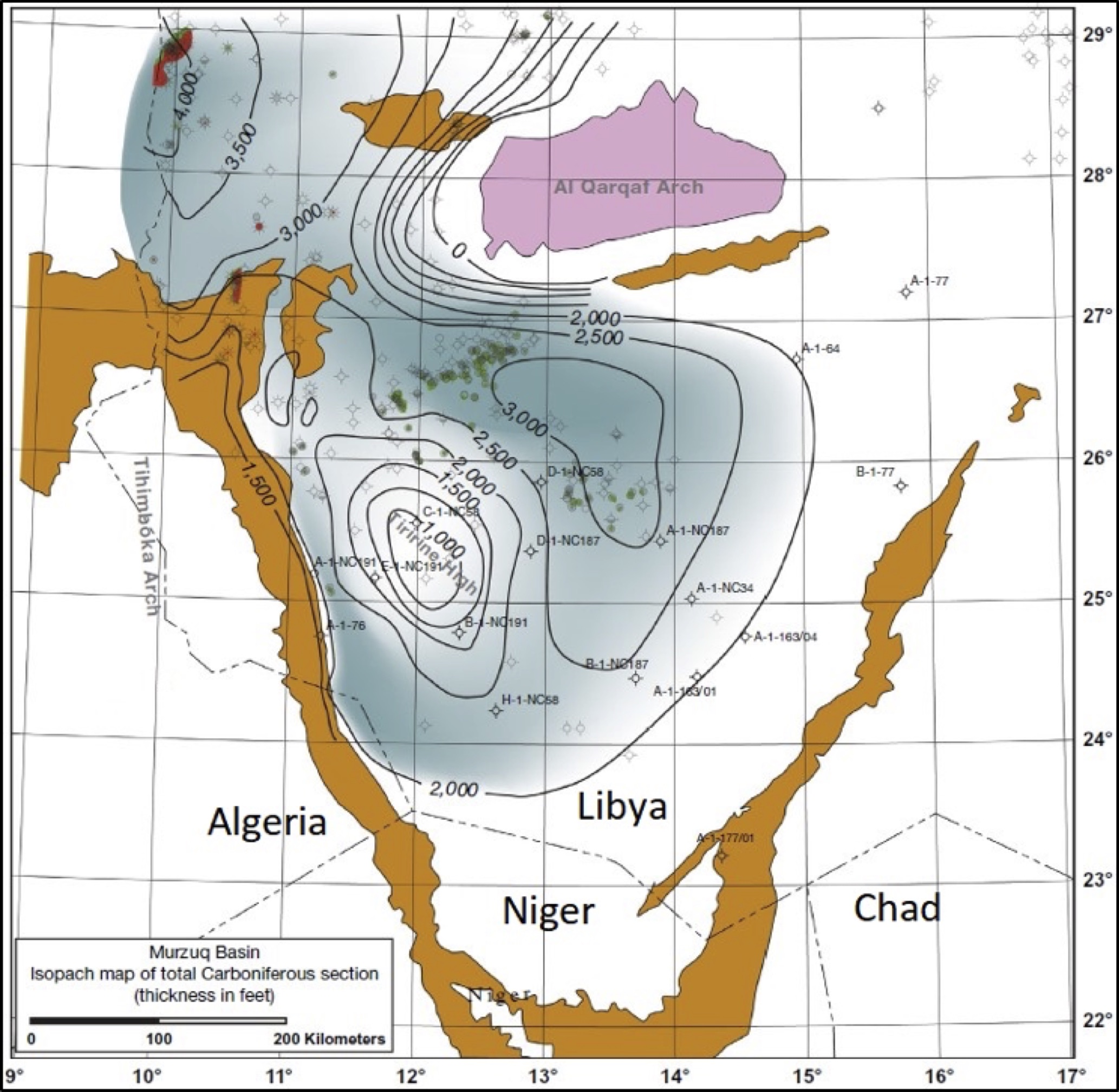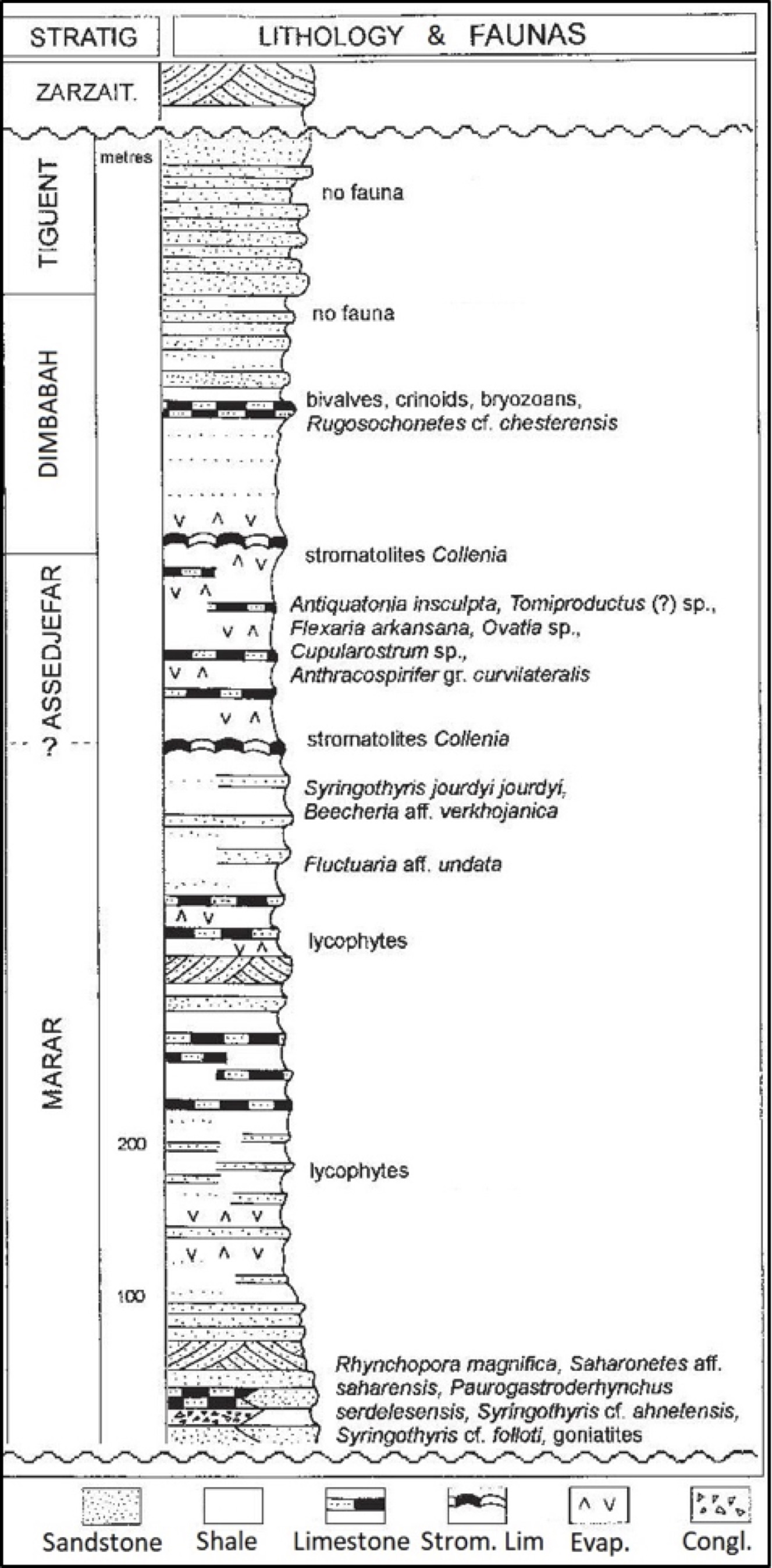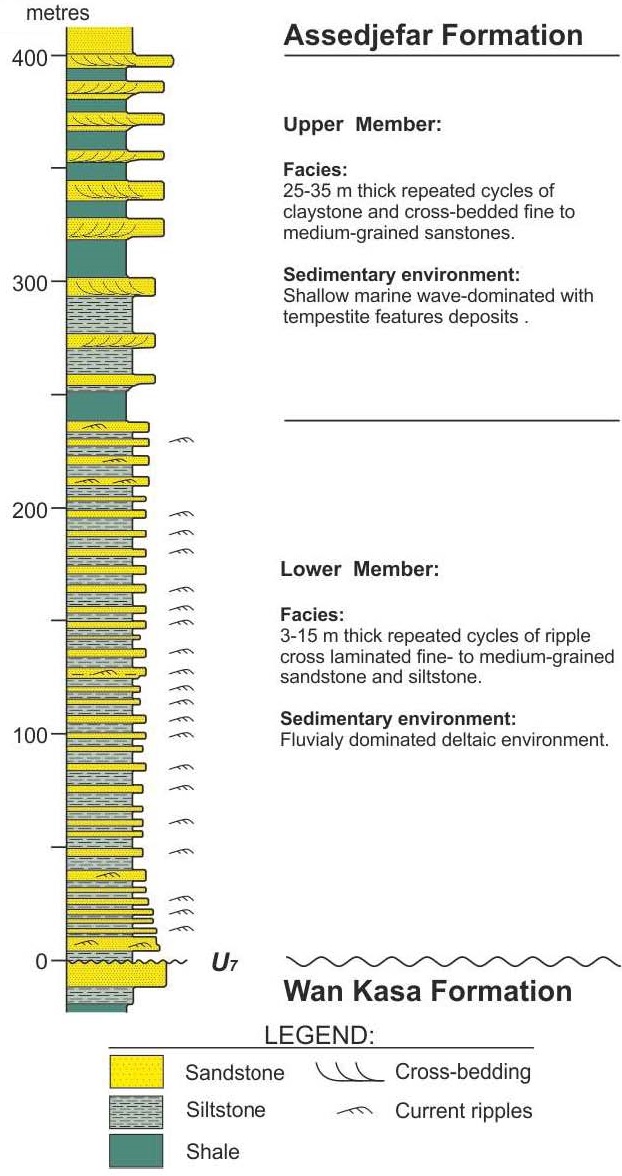Marar Fm
Type Locality and Naming
Type locality is Qararat (or Garat) al Marar northwest of the Al Qarqaf Arch, Libya (28°20′N, 12°15′E) (Lelubre, 1948). [Fig. 1]
References: Corsin, 1934; Plauchut & Faure, 1959; Jacqué, 1963; Danzé-Corsin, 1965; Lejal, 1968; Whitbread et al., 1982; De Rouvre, 1984; Lababidi et al., 1985; Lemoigne et al., 1992; Mergl et al., 2000, 2001; Fabre, 2005; Tawadros, 2011; Shalbak, 2015; Hallet, 2002, 2016.
Synonym: The former name of the formation was spelled "Mrar" or "M’Rar". The spelling was modified to its current form by Hallet (2002) after verifying the official name records of localities in Libya. An old name was the Serdeles Sandstone.
[Figure 1. Carboniferous outcrops of Algeria, Libya and northern Niger (Djado Basin – Marar Fm, Assedjefar Fm, Dimbabah Fm and lower part of the Tiguentourine Fm) (Source: Hallet, 2016).]
Lithology and Thickness
A sequence of alternating silty micaceous shales and micaceous, fine-grained, sandy and often ferruginous sandstones with interbedded siltstones and minor limestones. Five cycles are graded from deep water to coastal sedimentation showing fluctuating marine environment. In the basal Marar Fm, the lithology is highly diversified. The mainly green shales, but either with dolomitic limestones or calcareous sandstones, built up the formation locally with ferruginous oolites. In the upper part of the Marar Formation, several fossil associations indicate a Late Visean age. These fossil-bearing calcareous sandstones and limestones alternate with shales and siltstones. Fabre (2005) states that in the Djado, a 60 m thick horizon of dolomitic limestone, fine calcareous sandstones and shales is a good marker within the Marar Fm. Thickness: 450 m. The maximum cumulative thickness of all Carboniferous units in the Djado Basin (Marar Fm, Assedjefar Fm and Dimbabah Fm), known from surface and subsurface is 1000 to 1100 m. [See Fig. 2 and Fig. 3]
[Figure 2. Composite section of Carboniferous outcrops in the eastern Djado Basin (Source: Modified from Mergl et al., 2000, 2001).]
[Figure 3. Stratigraphic column of the Marar Formation at the Type Section]
Relationships and Distribution
Lower contact
Disconformable contact onto the underlying Awaynat Wanin Fm. Further to the South, the formation lies directly on the Lower Devonian Tadrart Fm with a lacune of the Awaynat Wanin Fm.
Upper contact
Conformably overlain by the Assedjefar Fm
Regional extent
GeoJSON
Fossils
The basal fossiliferous horizons are excellent regional markers over the whole area of the Djado Basin. Rich and diversified fauna, including brachiopods and Goniatites, indicates the first transgressive event in the Late Tournaisian.
The flora studied by Danzé-Corsin (1965) included: Archaeosigillaria subcosta P. Danze-Corsin; Lepidosigillaria quadrata P. Danze-Corsin; Lepidodendron tylodendroides Potonie, Lepidodendropsis (?) vandergrachti Jongmans, Gothan & Darrah; Cyclostigma cf. aegyptiaca Jongmans; Cyclostigma sp.; Knorria sp. The flora studied by Lejal A. (1968) included Heleniella costulata Lejal and Amadokia boureaui Lejal from Djebel Afati and Kouzandouga, and Lepidosigillaria whitei Krausel & Weyland; Lepidosigillaria quadrata P. Danze-Corsin; Lepidosigillaria intermedia Lejal; Lepidosigillaria aff. intermedia Lejal from Djebel Blaka.
In the late 1950s, French geological teams were assigned to a large-scale reconnaissance of the Djado area. Fossils collected during this fieldwork were deposited in the Natural History Museum in Paris for paleontological studies. The sandstones in the lower part of the Marar Fm contain a brachiopod-dominated community with abundant, medium-sized specimens of the coarsely costate syringothyfid Syringothyris cf. ahnetensis, locally associated with a large rhynchonellid taxon (Rhynchopora magnifica). Less abundant brachiopods at more or less the same level near the base of the Carboniferous sequence are Saharonetes saharensis and Schuchertella sp. The brachiopods occur in densely and often chaotically, packed beds, commonly isolated or broken valves, although some complete shells are also present. Bivalves are rare. The basal sandstones of the Marar Fm, resting unconformably on Devonian strata, contain the taxa Schuchertella sp. and Syringothyris sp., although in very limited numbers. Another distinct but low-diversity, the association at the base of the Carboniferous is characterized by the rhynchonellid Paurogastroderhynchus serdelesensis. The age of both associations is the latest Tournaisian. In the upper part of the Marar Formation, sandstones contain the characteristic Late Visean productid Fluctuaria undata. (Mergl et al. (2000).
Age
Depositional setting
According to Whitbread et al. (1982), the environment is a deltaic complex. The authors describe 15 sequences of increasing grain sizes, from shale to sandstones representing a transition from delta plain, beaches, tidal flats and the open sea.
Additional Information


